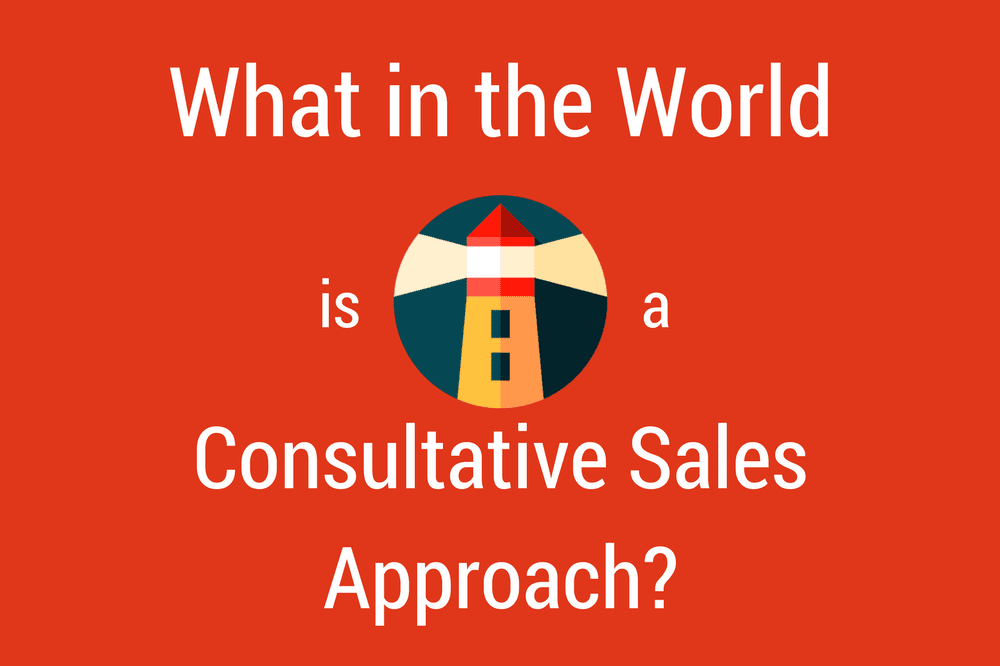Struggling to meet your sales goals? Quit selling so hard and adopt a consultative selling approach.
The term “sales representative” often carries a negative connotation. The term is reminiscent of traditional (read: outdated) sales tactics: an operator moving swiftly down a call list or a vacuum salesman walking door-to-door. People often assume sales representatives are sneaky, pushy, and dishonest, often employing borderline unethical selling techniques.
For so long, being sold to has been equated with being lied to. Buyers think that sales representatives will do whatever it takes to sell their product or service. To protect their personal and professional interests, B2B buyers have shifted their purchasing processes to independently seek out information about products and services. It’s become increasingly evident that buyers rely less on salespeople during the buying process.
How can sales representatives dispel people’s negative perceptions of them, remain relevant, and keep their seats at the table?
The answer is simpler than you might think: adopt a consultative sales approach.
Learn what other marketing tactics and approaches will work in 2020.
What is a Consultative Sales Approach?
Sometimes referred to as solution-based selling, the consultative sales approach is a method that focuses primarily on the buyer’s experience. Consultative sales centers around the buyer’s pain point and offers a solution to solve their problem. It’s not just about building rapport, it’s about truly helping them – sometimes with no strings attached.
Traditional, or transactional sales, is when a sales rep offers up a product before understanding the entire problem that is vexing their client. In the same way, some doctors might hear “itchy skin” and immediately assume a rash when it’s an allergic reaction to food. The medication for the rash will treat the rash itself, but the problem will keep persisting until the doctor treats the food allergy.
This might sound counter-intuitive, but believe it or not, it can lead to higher quality customers, increased trust, and more business down the road.
Instead of bombarding prospects with all the reasons they should buy your product, focus on their needs and act as a guiding light during the purchasing process.
Give Prospects The Information They Need

Since business buyers rely primarily on the internet to gather information about purchase decisions, your website is truly the first touchpoint with customers in a consultative sales approach. It’s important to make sure your website adequately represents the services you’re selling and answers high-level questions that buyers have.
Using Your Website as a Tool for Consultative Sales
Sixty percent of buyers say they only want to connect with a sales representative after they’ve done research online and have built a shortlist. So how can you reach potential leads in a thoughtful way? By providing high-quality content that addresses their pain points.
The internet has changed the way we buy products. At a glance, the process goes something like this:
- I recognize I have a problem
- I start to do some research by googling words associated with my problem
- As I do research I can better name my problem and start to identify potential solutions
- I generate a list of 3-4 possible solutions to my problem and start to find companies that can solve this
- I narrow my list of companies and schedule time to speak to a sales rep
- I choose my final vendor
Buyers aren’t looking to speak to anyone until step 5 giving you a great opportunity to be a helpful resource by providing various content (videos, blog posts) that answers a customer’s pain point.
Showing up during the research stage allows customers to get familiar with your brand and start associating you with helpful, relevant answers to their questions.
Wondering how to generate great blog content? We created a guide to get you started.
Once you’ve created great content, make sure it can be found online with search engine optimization.
Allowing potential customers the chance to do research means you’ll have less unqualified leads to dig through, and qualified prospects will be delighted that you’ve given them what they need.
Ask Open-Ended Questions: Stop Talking and Start Listening
The key to consultative selling is to be a good listener—not just listening to respond, but actually hearing what your prospect is saying. A good consultative sales representative is capable of looking beyond what a prospect identifies as the problem in order to uncover the real problem.
Don’t be afraid to dig deep and ask prospects to elaborate more on their pain points. Ask open-ended questions that start with who, what, when, where, why, and how.
Avoid asking questions that start with do, can, are, and will—these tend to yield yes or no answers, which are exactly what you want to don’t want in a consultative sales approach.
While most buyers believe they know how to overcome their challenges, this often isn’t the case. You’re the expert, so demonstrate your expertise by helping prospects define the true cause of their problems.
Practice Active Listening
Don’t simply ask good questions, but practice active listening as well. This further emphasizes the idea that you truly care about your lead’s problem, and that you’re committed to helping them solve it.
Here are some keys to successful active listening:
- Demonstrate concern
- Paraphrase their answers back to them
- Make sure your non-verbal cues demonstrate understanding: nodding, leaning in, etc…
- Dig in for further detail
Consult Prospects Through the Buying Process
Throughout the sales process, you should aim to uncover what your prospect’s goals are, the plan they have to reach these goals, the challenges they face, and the timeline they have in mind. As you gather more information from your prospect, your number one goal should be to help them.
Regardless what kinds of products of services you offer, it’s critical you offer them a tailored solution. Even if your business model may not be explicitly custom or tailored, this will make your prospect feel valued. Don’t lie to them about what you offer, but fight against the “cookie cutter” feel. Let them know exactly how your offering will benefit their business.
The solutions that you offer may or may not be related to your services. This is crucial. By focusing on solving your prospects’ problems no matter what, you send the message that you aren’t just trying to sell them something.
Buying is a gesture of trust, it is crucial to establish credibility and confidence with your prospects.
Close the Deal Naturally
When you’ve practiced consultative selling techniques through this point of the process, you’ve set yourself up well to close well and to close naturally.
Hubspot recommends digging into the consequences the lead might face if they don’t go with you. For instance, “What happens if this isn’t successful?” Or, “What happens if your purchase decision doesn’t work out?” This makes your lead really dig deep, and also paints the picture you truly care about their success.
After guiding your buyer through the process, asking great questions, listening well, and giving them all the information they need – the closing process should be fairly easy and feel natural for both parties. You’ve demonstrated your commitment to them. And because you haven’t employed sketchy or pushy sales tactics, you’ve built enough rapport that they can be honest with you about their decision. Even if they don’t wind up choosing you, you can feel confident they wouldn’t have been a good fit for your business.
Lastly, you’ve probably made a lasting impression. If they go with someone else because of an external factor like budget, they may come crawling back to you a few months later when they’ve realized you really cared, and knew the value of your offering.
When this is the case, don’t be afraid to continue marketing to them. The consultative selling approach can continue after a Closed / Lost situation. Feel free to make a sales call a few months to follow up – whether they’ve yet to make a decision or they went with someone else. Just do it in a way that doesn’t feel pushy.
“We just wanted to check in and see how x is going. Let us know if there’s anything we can do for you.”
It’s possible they simply weren’t able to afford your product or services. Later on down the road when they’ve grown in revenue, you’re at the top of their list due to how you made them feel during the sales process. If this is the case, be sure to keep your brand top of mind for them.
Consultative Sales is Relationship Building
When all’s said and done, a healthy buying and selling relationship is just that — a relationship. It’s about open communication, honesty, and candid advice on how to move forward. Sales representatives can break free of the long-standing negative stereotypes that have labeled them as dishonest and pushy by putting their prospects’ needs before their own, listening carefully, and making thoughtful recommendations.
Build good relationships. Do business the right way.
You’ll reap the benefits at some point.
Start the Conversation
Interested in learning more about our agency and how we operate?



